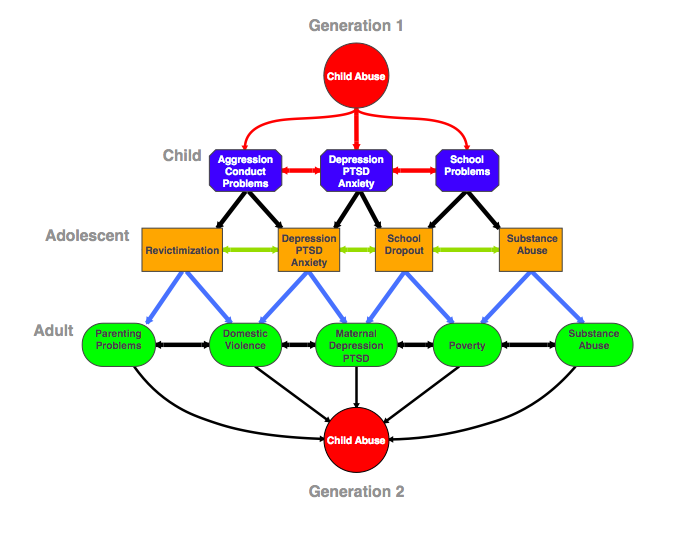
Corporal Punishment: A National Epidemic
Over 168 million Americans have experienced early childhood trauma. When these traumas are severe enough, they can have negative effects on health and wellbeing that manifest throughout the lives of the traumatized individuals, and on society as a whole.
A series of studies conducted by Kaiser Permanente and the Centers for Disease Control focused on the ten Adverse Childhood Experiences, or ACEs, that have the strongest adverse effects in later adulthood. Participants of the study self-reported whether they had experienced one of 10 significant early traumas in the areas of household dysfunction, neglect and abuse. The tests concluded that Kaiser patients who reported six or more ACEs would later have a 48% greater chance of contracting cancer, as well as a 20-year decreased life expectancy relative to patients who reported no major traumas. Just one ACE correlated with higher rates of obesity, alcoholism, suicide attempts, chronic depression and heart disease. Additional studies have estimated that the economic cost to society of early childhood traumas amounts to over $600 billion per year.

Despite this, between 80 and 90 percent of Americans were spanked or worse as children. About two-thirds of adults rationalize this behavior by saying that it was good for them and that refusing to use corporal punishment to discipline their own children would be irresponsible. However, 80% of child abuse cases start by parents spanking their children and then getting carried away. 20 U.S. states still allow corporal punishment in schools, and not a single state bans it entirely. The American Academy of Pediatrics recognizes the evidence of hundreds of studies that agree spanking and corporal punishment lead to poor child behavior, yet nearly 60% of pediatricians still condone corporal punishment as a disciplinary method. Many people mistakenly believe the phrase ‘Spare the rod, spoil the child,’ comes from the Bible and use it to rationalize harsh discipline. The reality is that if you spare the rod, you save the child.
In order to prevent the widespread use of corporal punishment, its lasting traumatic ramifications must be discussed. Fortunately, 52 countries have already banned corporal punishment on children, the latest being France. Countries that have passed laws preventing corporal punishment of children have reported a decrease in violent crimes, with some such as Sweden and Denmark closing prisons due to the lack of crime. Laws have also helped changed the cultural perception of violence toward children in these countries.
The U.S., however, has very few legal child protections. Child Protective Services investigates over three million incidences of child abuse, maltreatment, or endangerment each year, and most of these investigations involve children under thee years. Despite the “culture of violence,” 85% of parents who have used corporal punishment responded to a questionnaire that they were open to a better way of parenting. Many parents who traumatize their children through neglect and verbal abuse are also open to a better way of raising their kids. In order to properly prevent trauma, systems must target the period of early childhood, preventing parents from traumatizing their children and subjecting them to the gamut of risks that come with ACEs.
Sadly, ACEs are still common in our society. 52.1% of adults have experienced at least one ACE as a child, and 25% reported two or more ACEs. It should be noted that the ACE studies were conducted within a population that had good health insurance and higher education levels than the average American. Inner city, poor populations have a higher prevalence of violence and single parents. The ACE study was based on self-reported traumas; the real percentage of traumatized Americans is likely much higher. Many people have repressed traumas of which they are no longer consciously aware. In addition, people’s first memories are between the ages of three and eight; many traumas are suffered in the first three years of life. Even if the individual cannot remember the trauma, they are likely still suffering the consequences.
For more information on ACEs:
Prevalence of Corporal Punishment in the United States
Unfortunately, corporal punishment is still perceived to be an acceptable means of parenting despite the conflicting evidence. Studies from the
Read more.Relationship of Childhood Abuse and Household Dysfunction to Many of the Leading Causes of Death in Adults
“The relationship of health risk behavior and disease in adulthood to the breadth of exposure to childhood emotional, physical, or
Read more.Spanking in Early Childhood and Later Behavior Problems: A Prospective Study of Infants and Young Toddlers
Corporal punishment has severe and lasting effects on children. The abuse can often manifest itself through mental issues of the
Read more.Longitudinal Links Between Spanking and Children’s Externalizing Behaviors in a National Sample of Families
This study analyzes the cultural contexts of spanking since the majority of research is performed on middle-class causation Americans. This
Read more.Spanking by Parents and Subsequent Antisocial Behavior of Children
A scientific study that sought to address the correlations between corporal punishment and antisocial behaviors. The findings demonstrate that when
Read more.Physical Punishment and Mental Disorders: Results from a Nationally Representative US Sample
A plethora of research has linked corporal punishment to lasting mental health issues. Physical aggression towards children may yield mental
Read more.The Progression of Child Abuse
Child abuse is often passed generationally. Usually the first symptoms manifest themselves through aggression issues and problems in academia. Mental
Read more.Vincent Felitti ACE Studies Abstract
Vincent Felitti’s research cited below summarizes some of the lasting ramifications that dysfunctional familial environments can have on children: Abstract
Read more.Child Abuse Statistics
More than 81 percent of perpetrators of child abuse are parents. Another 6 percent are relatives of the victim.* Children
Read more.










